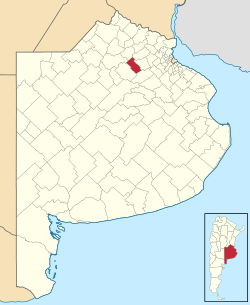|
Suipacha Partido
Suipacha Partido is a partido of Buenos Aires Province in Argentina. The provincial subdivision has a population of about 9,000 inhabitants and an area of 943.87 km2 (364.43 sq mi). Its capital city is Suipacha, which is around 101 km (63 mi) from Buenos Aires. Adjacent partidosSuipacha borders the partidos of Carmen de Areco, San Andrés de Giles and Chacabuco to the north, Mercedes to the east, Navarro to the south, and Chivilcoy to the west. PopulationAccording to estimates for June 2007 the population was 9,406 inhabitants.[1]
HistorySuipacha land originally belonged to the partidos of Mercedes, San Andres de Giles, Carmen de Areco, Chivilcoy and Navarro, part of the section Areco. This district was created by Act of October 24, 1864, determined their limits by decree of February 24, 1865. The name commemorates the first battle won by the patriotic arms in the War of Independence fought in the territory of Bolivia (Upper Peru) on November 7, 1810 between the royal army and the forces commanded by General Antonio González Balcarce, with the outstanding performance of Martin Miguel de Guemes. The area of the present partido of Suipacha integrated the Hinterland of Salado, where the games were organized long before the outside line borders. The Indian problem after the May Revolution became more increase and governments must deal over advancement of the various boundary lines, which for almost a century remained in the Salado River; one of the first guards established was to Luján (now Mercedes) in 1752 on the banks of the river of the same name and the fort Areco from 1771 defended the first settlers who settled on the Luján River and its tributary, the Arroyo de los lions. AI respect of the Areco forts and then enfiteusis law passed in 1826 by Rivadavia, get the earliest settlers who as the oldest surveying were Samuel Bishop, José Viñas, Mariano Cruz, Bias Peak, Jose Ferreyra, Norberto Martinez, Pedro Veloz ; Santiago Rojas, Antonio Suarez (grandfather of the founder), Juan Bautista Rodriguez, Second Costa, Pablo Martinez, Toribio Freire Benito Baldeares, Baltazar Witt, Saturnino Unzué and Pedro Mones Ruiz. Western Railroad opened the line between Mercedes and Chivilcoy in 1866, and thereafter after several stations, including Freire, on land owned by Toribio Freire from whom a corner of his field was expropriated for the purpose. The land where the town was formed in 1860 belonged to Pascual Suarez passing later by her daughter Rosario Suarez married in first nuptials with Basilio Labat. These two people applied for the May 11, 1875 the Superior Government the formation of a people in their own land, located around the Casco stay at the highest point called Cerrito del Durazno Freire and adjoining the station. Appended drawings that had been raised by surveyor Pedro Saubidet and were referred to the Department of Engineers who reported on August 28, 1875 approving the formation of a people with the name of Suipacha and making some comments on the trace of it. The objections are answered personally Rosario Suarez, who had been widowed on 18 July of that year. On 24 September 1875 the Executive approved the plan of the town of Mercedes seconded the measures indicated by the further expresses Topographic Department and the prosecutor Fernandez to pass the case to the Government Notary deed for the land to be donated to raise public buildings. On 31 May 1879 the executive issues a decree declaring head of the party's people Suipacha, designating the following authorities: Magistrate Don Felipe Videla, Military Commander Urbano Alvarez, Municipal Commission: León Billourou (second husband founder), Juan Laborda, Tomás Gaham and Leopoldo Bernal as starters, with alternates and Marcelo Mones Damian Solomon.
SettlementsSymbolsCoat of arms of SuipachaBy decree of 15.05.1970 the municipal commissioner of the Military Government D. Manuel Miguel Mujica required the Board of Genealogy and Heraldry of Buenos Aires creating a shield, which was approved. It refers to the fact that names weapons to the people and to the patron of the same Nuestra Señora del Rosario. References
External linksWikimedia Commons has media related to Suipacha Partido. |
||||||||||||||||||||||||||||||||||||||||||||||||||||||
